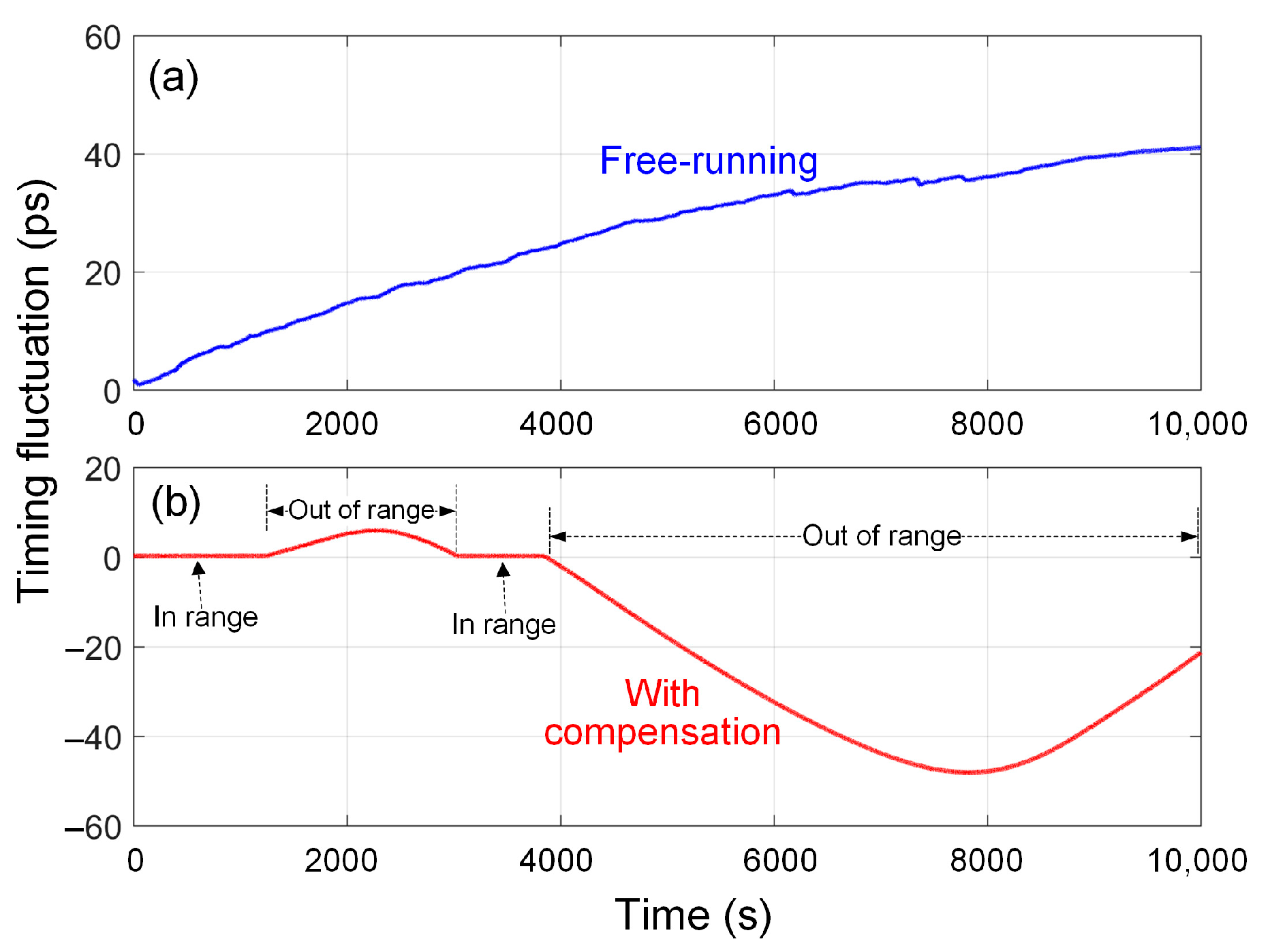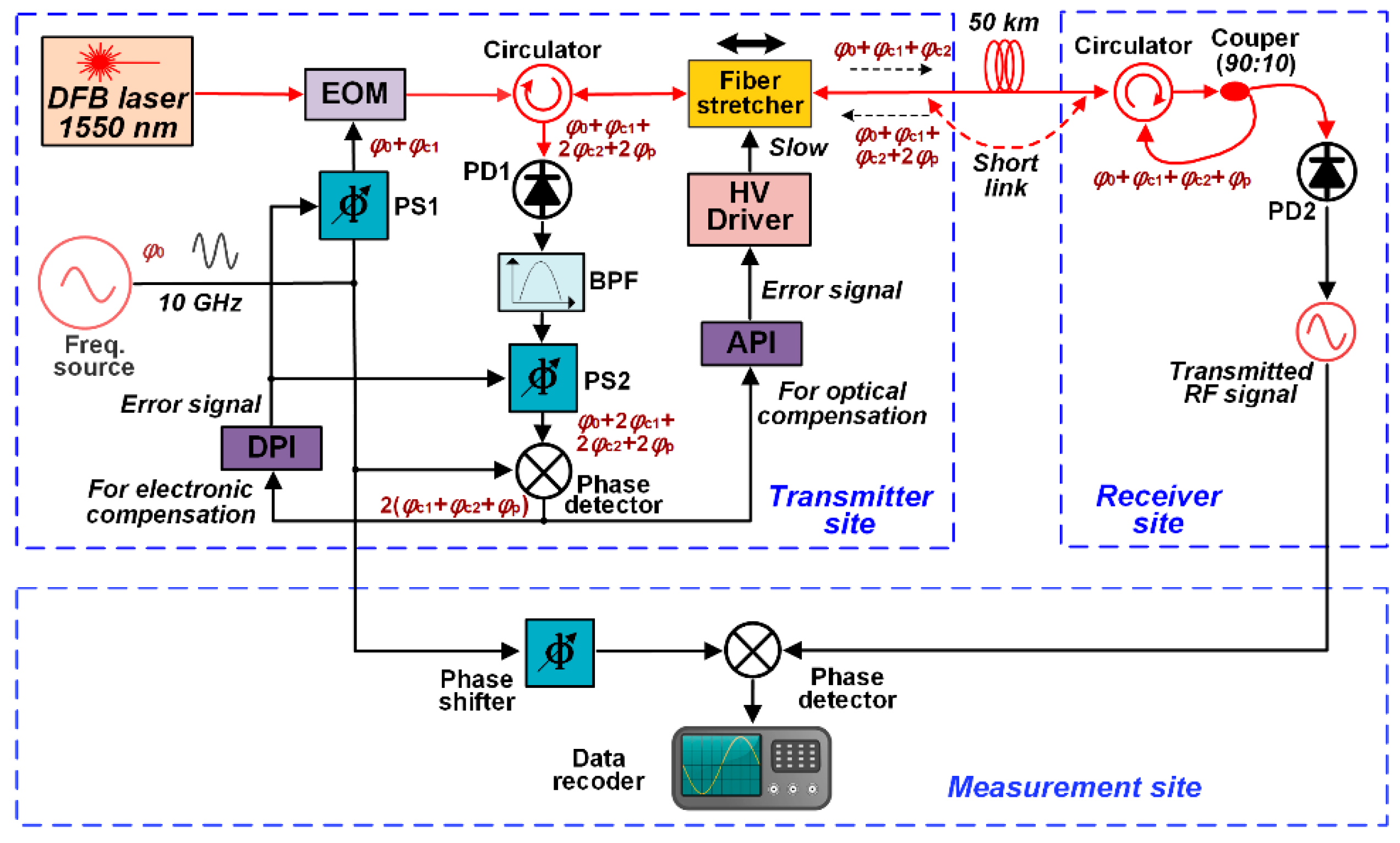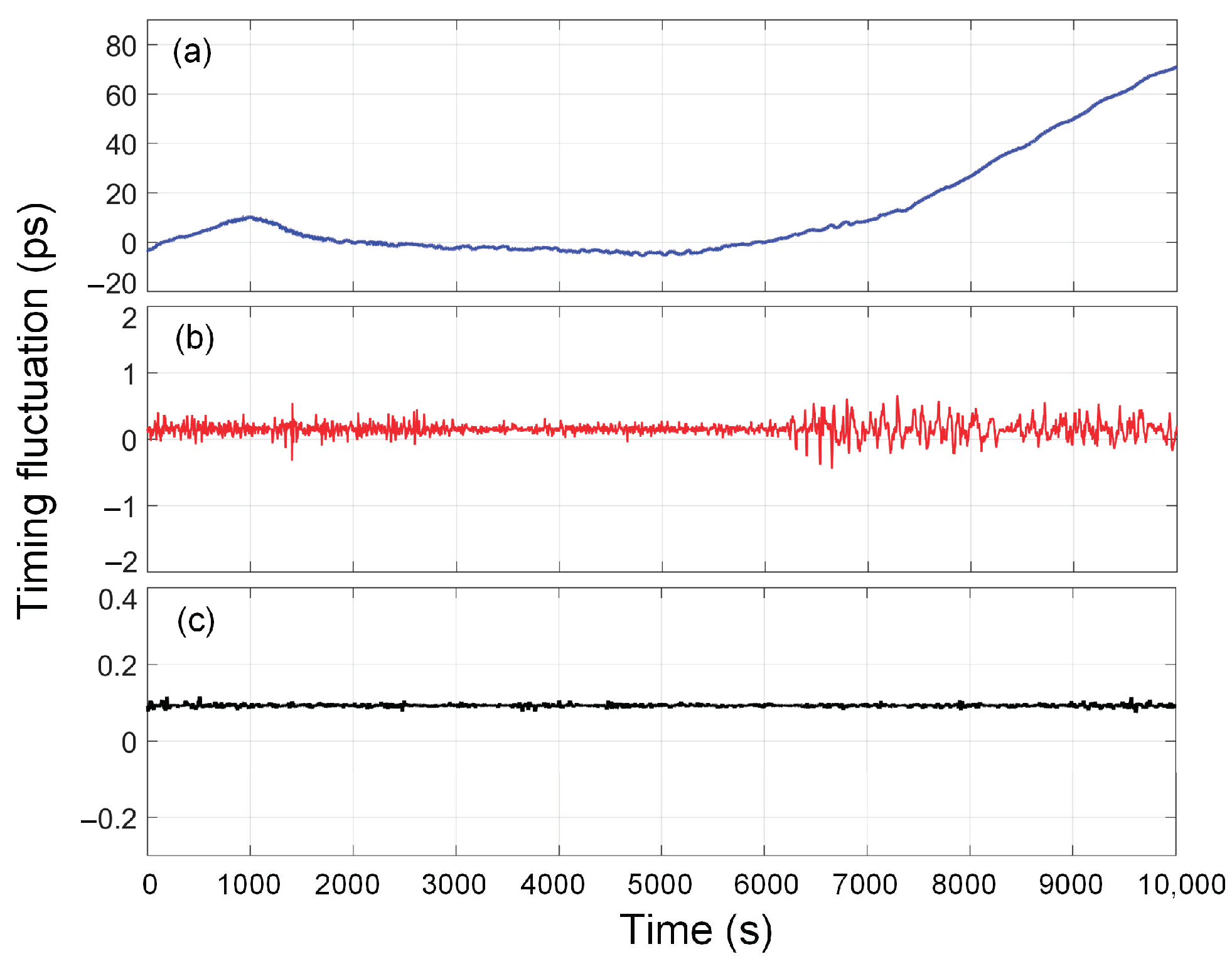Femtosecond-Level Frequency Transfer at 10 GHz over Long Fiber Link with Optical–Electronic Joint Compensation
Abstract
:1. Introduction
2. Limit of Optical Phase Compensation
3. Scheme Using Optical–Electronic Joint Phase Compensation
4. Experimental Results
4.1. Timing Fluctuation
4.2. Frequency Instability
5. Discussion
6. Conclusions
Author Contributions
Funding
Institutional Review Board Statement
Informed Consent Statement
Data Availability Statement
Acknowledgments
Conflicts of Interest
References
- Levine, J. A review of time and frequency transfer methods. Metrologia 2008, 45, 162–174. [Google Scholar] [CrossRef]
- Predehl, K.; Grosche, G.; Raupach, S.M.F.; Droste, S.; Terra, O.; Alnis, J.; Legero, T.; Hansch, T.W.; Udem, T.; Holzwarth, R.; et al. 920-Kilometer Optical Fiber Link for Frequency Metrology at the 19th Decimal Place. Science 2012, 336, 441–444. [Google Scholar] [CrossRef]
- He, Y.; Baldwin, K.G.H.; Orr, B.J.; Warrington, R.B.; Wouters, M.J.; Luiten, A.N.; Mirtschin, D.P.; Tzioumis, T.; Phillips, C.; Stevens, J.; et al. Long-distance telecom-fiber transfer of a radio-frequency reference for radio astronomy. Optica 2018, 5, 138–146. [Google Scholar] [CrossRef] [Green Version]
- Li, B.H.; Rizos, C.; Lee, H.K.; Lee, H.K. A GPS-slaved time synchronization system for hybrid navigation. GPS Solut. 2006, 10, 207–217. [Google Scholar] [CrossRef]
- Foreman, S.M.; Holman, K.W.; Hudson, D.D.; Jones, D.J.; Ye, J. Remote transfer of ultrastable frequency references via fiber networks. Rev. Sci. Inst. 2007, 78, 021101. [Google Scholar] [CrossRef] [Green Version]
- Kim, J.; Cox, J.A.; Chen, J.; Kärtner, F.X. Drift-free femtosecond timing synchronization of remote optical and microwave sources. Nat. Photon. 2008, 2, 733–736. [Google Scholar] [CrossRef]
- Musha, M.; Hong, F.L.; Nakagawa, K.; Ueda, K. Coherent optical frequency transfer over 50-km physical distance using a 120-km-long installed telecom fiber network. Opt. Express 2008, 16, 16459–16466. [Google Scholar] [CrossRef]
- Williams, P.A.; Swann, W.C.; Newbury, N.R. High-stability transfer of an optical frequency over long fiber-optic links. J. Opt. Soc. Am. B 2008, 25, 1284–1293. [Google Scholar] [CrossRef]
- Jiang, H.; Kefelian, F.; Crane, S.; Lopez, O.; Lours, M.; Millo, J.; Holleville, D.; Lemonde, P.; Chardonnet, C.; Amy-Klein, A.; et al. Long-distance frequency transfer over an urban fiber link using optical phase stabilization. J. Opt. Soc. Am. B 2008, 25, 2029–2035. [Google Scholar] [CrossRef] [Green Version]
- Grosche, G.; Terra, O.; Predehl, K.; Holzwarth, R.; Lipphardt, B.; Vogt, F.; Sterr, U.; Schnatz, H. Optical frequency transfer via 146 km fiber link with 10−19 relative accuracy. Opt. Lett. 2009, 34, 2270–2272. [Google Scholar] [CrossRef]
- Daussy, C.; Lopez, O.; Amy-Klein, A.; Goncharov, A.; Guinet, M.; Chardonnet, C.; Narbonneau, F.; Lours, M.; Chambon, D.; Bize, S.; et al. Long-distance frequency dissemination with a resolution of 10-17. Phys. Rev. E. 2005, 94, 203904. [Google Scholar]
- Chen, Y.F.; Jiang, J.; Jones, D.J. Remote distribution of a mode-locked pulse train with sub 40-as jitter. Opt. Express 2006, 14, 12134–12144. [Google Scholar] [CrossRef] [PubMed]
- Lopez, O.; Amy-Klein, A.; Daussy, C.; Chardonnet, C.; Narbonneau, F.; Lours, M.; Santarelli, G. 86-km optical link with a resolution of 2 x 10-18 for RF frequency transfer. Eur. Phys. J. D 2008, 48, 35–41. [Google Scholar] [CrossRef] [Green Version]
- Kumagai, M.; Fujieda, M.; Nagano, S.; Hosokawa, M. Stable radio frequency transfer in 114 km urban optical fiber link. Opt. Lett. 2009, 34, 2949–2951. [Google Scholar] [CrossRef]
- Lenihan, A.S.; Sinkin, O.V.; Marks, B.S.; Tudury, G.E.; Runser, R.J.; Goldman, A.; Menyuk, C.R.; Carter, G.M. Nonlinear timing jitter in an installed fiber network with balanced dispersion compensation. IEEE Photonic. Technol. Lett. 2005, 17, 1558–1560. [Google Scholar] [CrossRef] [Green Version]
- Hou, D.; Li, P.; Xi, P.; Zhao, J.; Zhang, Z. Timing jitter reduction over 20-km urban fiber by compensating harmonic phase difference of locked femtosecond comb. Chin. Opt. Lett. 2010, 8, 993–995. [Google Scholar] [CrossRef]
- Kim, J.; Chen, J.; Zhang, Z.; Wong, F.N.C.; Kärtner, F.X.; Loehl, F.; Schlarb, H. Long-term femtosecond timing link stabilization using a single-crystal balanced cross correlator. Opt. Lett. 2007, 32, 1044–1046. [Google Scholar] [CrossRef]
- Holman, K.W.; Jones, D.J.; Hudson, D.D.; Ye, J. Precise frequency transfer through a fiber network by use of 1.5-mu m mode-locked sources. Opt. Lett. 2004, 29, 1554–1556. [Google Scholar] [CrossRef] [PubMed] [Green Version]
- Holman, K.W.; Hudson, D.D.; Ye, J.; Jones, D.J. Remote transfer of a high-stability and ultralow-jitter timing signal. Opt. Lett. 2005, 30, 1225–1227. [Google Scholar] [CrossRef]
- Deschenes, J.D.; Sinclair, L.C.; Giorgetta, F.R.; Swann, W.C.; Baumann, E.; Bergeron, H.; Cermak, M.; Coddington, I.; Newburry, N.R. Synchronization of distant optical clocks at the femtosecond level. Phys. Rev. X 2016, 6, 021016. [Google Scholar] [CrossRef] [Green Version]
- Hou, D.; Li, P.; Liu, C.; Zhao, J.; Zhang, Z. Long-term stable frequency transfer over an urban fiber link using microwave phase stabilization. Opt. Express 2011, 19, 506–511. [Google Scholar] [CrossRef]
- Chen, X.; Zhang, J.; Lu, J.; Lu, X.; Tian, X.; Liu, B.; Wu, H.; Tang, T.; Shi, K.; Zhang, Z. Feed-forward digital phase compensation for long-distance precise frequency dissemination via fiber network. Opt. Lett. 2015, 40, 371–374. [Google Scholar] [CrossRef]
- Wang, B.; Zhu, X.; Gao, C.; Bai, Y.; Dong, J.; Wang, L. Square kilometre array telescope—Precision reference frequency synchronisation via 1f-2f dissemination. Sci. Rep. 2015, 5, 13851. [Google Scholar] [CrossRef] [Green Version]
- Lessing, M.; Margolis, H.S.; Brown, C.T.A.; Marra, G. Frequency comb-based time transfer over a 159 km long installed fiber network. Appl. Phys. Lett. 2017, 110, 221101. [Google Scholar] [CrossRef] [Green Version]
- Ning, B.; Zhang, S.Y.; Hou, D.; Wu, J.T.; Li, Z.B.; Zhao, J.Y. High-precision distribution of highly stable optical pulse trains with 8.8 × 10–19 instability. Sci. Rep. 2014, 4, 5109. [Google Scholar] [CrossRef] [Green Version]
- Huang, W.; Li, Z.; Gao, Y.; Hou, D. Fiber-Based Transfer of Radio-Frequency at X-Band with Femtosecond Timing Fluctuation Using Optical Phase Compensation. In Proceedings of the 2021 IEEE 21st International Conference on Communication Technology (ICCT), Tianjin, China, 13–16 October 2021; pp. 1515–1518. [Google Scholar]
- Liu, Z.; Xie, W.; Wei, W.; Deng, N.; Dong, Y. Theoretical analysis for fiber-optic distribution of rf signal based on phase-locked loop. Opt. Express 2020, 28, 19851–19863. [Google Scholar] [CrossRef]
- Wang, B.; Gao, C.; Chen, W.; Miao, J.; Wang, L. Precise and continuous time and frequency synchronisation at the 5 × 10−19 accuracy level. Sci. Rep. 2012, 2, 556. [Google Scholar] [CrossRef] [Green Version]
- Wu, R.; Lin, J.; Jiang, T.; Liu, C.; Yu, S. Stable radio frequency transfer over fiber based on microwave photonic phase shifter. Opt. Express 2019, 27, 38109–38115. [Google Scholar] [CrossRef] [PubMed]
- Tian, J.; Li, X.; Ji, Z.; Geng, X.; Mao, Y.; Hou, D. Sub-Hundred-Femtosecond Atmospheric Radio-Frequency Transfer with Frequency Comb Using Fast Optical Phase Compensation. In Proceedings of the 2021 IEEE 21st International Conference on Communication Technology (ICCT), Tianjin, China, 13–16 October 2021; pp. 1500–1503. [Google Scholar]
- Guo, G.; Hou, D.; Sun, F.; Liu, K.; Xiao, Y.; Wang, H. Laser-based atmospheric radio-frequency transfer with sub-picosecond timing fluctuation using single phase compensator. Opt. Commun. 2018, 426, 526–530. [Google Scholar] [CrossRef]
- Chen, S.; Sun, F.; Bai, Q.; Chen, D.; Chen, Q.; Hou, D. Sub-picosecond timing fluctuation suppression in laser-based atmospheric transfer of microwave signal using electronic phase compensation. Opt. Commun. 2017, 401, 18–22. [Google Scholar] [CrossRef]
- Microsemi Corporation. MHM 2010 the World’s Most widely Installed Active Hydrogen Maser for Applications that Require Extreme Frequency Stability, Low Phase Noise and Long Service Life; Microsemi Corporation: San Jose, CA, USA, 2020; Available online: https://www.microsemi.com/product-directory/active-hydrogen-maser/4123-mhm-2010-active-hydrogen-maser (accessed on 10 September 2022).
- Ye, J.; Peng, J.L.; Jones, R.J.; Holman, K.W.; Hall, J.L.; Jones, D.J.; Diddams, S.A.; Kitching, J.; Bize, S.; Bergquist, J.C.; et al. Delivery of high-stability optical and microwave frequency standards over an optical fiber network. J. Opt. Soc. Am. B 2003, 20, 1459–1467. [Google Scholar] [CrossRef]
- Kim, J.; Ludwig, F.; Felber, M.; Kartner, F.X. Long-term stable microwave signal extraction from mode-locked lasers. Opt. Express 2007, 15, 8951–8959. [Google Scholar] [CrossRef] [PubMed] [Green Version]
- Narbonneau, F.; Lours, M.; Bize, S.; Clairon, A.; Santarelli, G.; Lopez, O. High resolution frequency standard dissemination via optical fiber metropolitan network. Rev. Sci. Inst. 2006, 77, 064701. [Google Scholar] [CrossRef]
- Marra, G.; Margolis, H.S.; Lea, S.N.; Gill, P. High-stability microwave frequency transfer by propagation of an optical frequency comb over 50 km of optical fiber. Opt. Lett. 2010, 35, 1025–1027. [Google Scholar] [CrossRef]
- Wu, Z.L.; Dai, Y.T.; Yin, F.F.; Xu, K.; Li, J.Q.; Lin, J.T. Stable radio frequency phase delivery by rapid and endless post error cancellation. Opt. Lett. 2013, 38, 1098–1100. [Google Scholar] [CrossRef]
- Jung, K.; Lim, J.; Shin, J.; Yang, H.; Chen, L.J.; Kartner, F.X.; Kang, H.S.; Min, C.K.; Kim, J. Remote Laser-Microwave Synchronization Over Kilometer-Scale Fiber Link With Few-Femtosecond Drift. J. Lightwave Technol. 2014, 32, 3742–3748. [Google Scholar] [CrossRef]
- Wang, X.C.; Liu, Z.W.Y.; Wang, S.W.; Sun, D.N.; Dong, Y.; Hu, W.S. Photonic radio-frequency dissemination via optical fiber with high-phase stability. Opt. Lett. 2015, 40, 2618–2621. [Google Scholar] [CrossRef]
- Liang, J.X.; Liu, C.X.; Hu, F.; Zhou, S.J.; Yu, S.; Qiao, Y.J. Stable radio-frequency dissemination system of single wavelength with passive compensation and remote reconstruction. Opt. Commun. 2019, 445, 161–164. [Google Scholar] [CrossRef]
- Deng, N.; Wei, W.; Liu, Z.W.Y.; Xie, W.L.; Dong, Y. Distribution of optical-comb-based multi-frequency microwave signals over 100 km optical fiber with high phase stability. Opt. Express 2020, 28, 16634–16643. [Google Scholar] [CrossRef]
- Wang, J.L.; Yue, C.L.; Xi, Y.L.; Sun, Y.G.; Cheng, N.; Yang, F.; Jiang, M.Y.; Sun, J.F.; Gui, Y.Z.; Cai, H.W. Fiber-optic joint time and frequency transfer with the same wavelength. Opt. Lett. 2020, 45, 208–211. [Google Scholar] [CrossRef] [Green Version]
- Yu, C.L.; Guo, H.; An, Z.Y.; Li, Y.H.; Zheng, Z. Self-referenced distribution of millimeter waves over 10 km optical fiber with high frequency stability. Opt. Lett. 2021, 46, 3949–3952. [Google Scholar] [CrossRef] [PubMed]





| Authors | Year | Optical/Electronic Compensation | Frequency | Distance | Timing Fluctuation |
|---|---|---|---|---|---|
| Ye, J. et al. [34] | 2003 | Optical | 1 GHz | 3.45 km | ~160 ps (0.5 rad) |
| Kim, J. et al. [35] | 2007 | Optical | 10.225 GHz | Short link | ~100 fs (3 mrad) |
| Narbonneau, F. et al. [36] | 2007 | Electronic | 100 MHz | 2.5 km | ~1.3 ps (0.3 mrad) |
| Kim, J. et al. [6] | 2008 | Optical | 10.225 GHz | 300 m | 6.8 fs |
| Kumagai, M. et al. [14] | 2009 | Electronic | 1 GHz | 114 km | 30 ps |
| Marra, G. et al. [37] | 2010 | Optical | 1.5 GHz | 50 km | NA * |
| Hou, D. et al. [21] | 2011 | Electronic | 100 MHz | 80 km | 16 ps |
| Wu, Z. et al. [38] | 2013 | Electronic | 2.81 GHz | 10 km | ~79 ps (0.05 rad) |
| Jung, K. et al. [39] | 2014 | Optical | 2.856 GHz | 610 m | 2.7 fs |
| Wang, X. et al. [40] | 2015 | Electronic | 20.07 GHz | 100 km | 1 ps |
| Liang, J. et al. [41] | 2019 | Electronic | 2.4 GHz | 80 km | NA * |
| Deng, N. et al. [42] | 2020 | Optical | 10.015 GHz | 100 km | 580 fs |
| Wang, J. et al. [43] | 2020 | Electronic | 1 GHz | 110 km | 200 fs |
| Yu, C. et al. [44] | 2021 | Electronic | 26 GHz | 10 km | 160 fs |
Publisher’s Note: MDPI stays neutral with regard to jurisdictional claims in published maps and institutional affiliations. |
© 2022 by the authors. Licensee MDPI, Basel, Switzerland. This article is an open access article distributed under the terms and conditions of the Creative Commons Attribution (CC BY) license (https://creativecommons.org/licenses/by/4.0/).
Share and Cite
Huang, W.; Li, Y.; Zhang, P.; Fang, L.; Hou, D. Femtosecond-Level Frequency Transfer at 10 GHz over Long Fiber Link with Optical–Electronic Joint Compensation. Appl. Sci. 2022, 12, 11262. https://doi.org/10.3390/app122111262
Huang W, Li Y, Zhang P, Fang L, Hou D. Femtosecond-Level Frequency Transfer at 10 GHz over Long Fiber Link with Optical–Electronic Joint Compensation. Applied Sciences. 2022; 12(21):11262. https://doi.org/10.3390/app122111262
Chicago/Turabian StyleHuang, Wantao, Yang Li, Peng Zhang, Lujun Fang, and Dong Hou. 2022. "Femtosecond-Level Frequency Transfer at 10 GHz over Long Fiber Link with Optical–Electronic Joint Compensation" Applied Sciences 12, no. 21: 11262. https://doi.org/10.3390/app122111262





